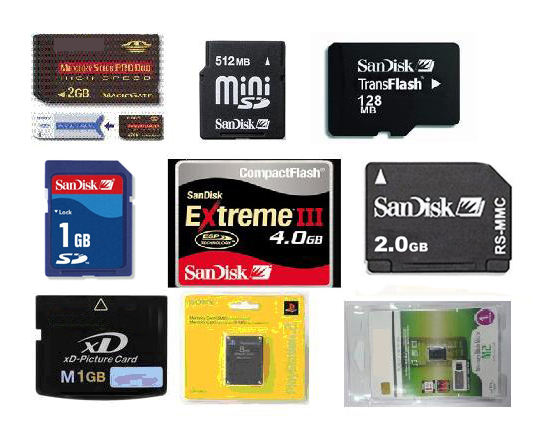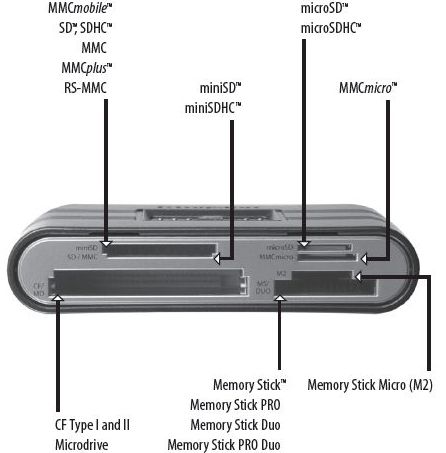

Posted on 05/05/2012 2:05:09 PM PDT by djf
Quick stop at a garage sale and grabbed this thingamajig called a "CameraMate".
USB plug into my computer.
Accepts 4 types of memory cards, the only type I have is a Compactflash (which I don't really use, I use USB sticks, but it is a curiosity).
So I am wondering about the other types of cards this thing can read and what their sizes/types/usages are.
There's a slot for MS, a slot for SD, a slot for CF (Compactflash), and a slot for xD/SM
Anyone know the skinny on these other card types?
Thankx!!
Does it accept MicroSD? Does it support SDHC (high capacity — anything over 4 MB IIRC)?
Pretty much all my devices are SD(HC) or MicroSD(HC), usually with 32GB.
I dunno, that’s why I’m asking, I have no clue about the different types/sizes/configurations, etc.
Thanks!
That’s what I needed. I wasn’t sure what to even start googling with...
There are a whole lot of card formats out there, but the most predominant one is SD (the “HC” means High Capacity). SDHC currently go up to 128 Gb (I don’t know what the theoretical upper limit is).
There are 3 sizes of SD — Micro (usually for PDAs and Cell phones) - about 1/4” by 1/2” or so. Mini (not seen very often) is about 3/4” by 3/4”. Normal/standard is about 1” x 7/8” or so.
Sony introduced a technology called memory stick. They like to put it in all their products, but eventually gave in and starting using SD. Mo one actually USES Memory Stick.
The other cards and formats don’t get a lot of use.
Maybe some FReeper with knowledge of the Next Great Thing can let us know what he/she is seeing...
xD cards are used in Olympus cameras; IIRC Fuji cameras as well.
Micro SD cards are pretty much the only format used in phones and MP3 players now. They usually come with an adapter to fit into any SD card reader.
Probly flat tip, phillips, clutch, and a few more but you will definatly find one that it doesnt work with and have to go buy another gadget to complete your task.


Nice pics! I use the blue one in most of my devices which is the size of a thumbnail. The one in my cellphone is this tiny black thing about 1/4 of the blue ones size. To fit my 80’s mind, is this a VHS vs Beta thing? Which one is most likely to last? Thanks!
LOL! Memories.
Everything you’ll ever want to know about camera cards:
http://en.wikipedia.org/wiki/Memory_card
Nice pics! I use the blue one in most of my devices which is the size of a thumbnail. The one in my cellphone is this tiny black thing about 1/4 of the blue ones size. To fit my 80’s mind, is this a VHS vs Beta thing? Which one is most likely to last? Thanks!
“xD cards are used in Olympus cameras; IIRC Fuji cameras as well.”
Correct, but I believe they have changed to SD for more recent cameras.
I got a Fuji a few months back, with SD.
The x/D cards were used in older Fuji and Olympus digital cameras. However, I believe that newer models have switched to the more common SD cards.
But seriously folks, My present camera uses CF ("Compact Flash") cards. My tower computer now has a built-in slot for it, and my notebook can get by with a CF-to-USB adapter. BTW, "Flash" in this context means the type of memory technology ("Flash erase"); nothing to do with a camera flash. All current portable solid-state memories actually use "Flash" EEPROM. This form merely has it in its name.
My audio recorder uses SD (Secure Digital) cards, and both my computers have slots for those.
For general storage, such as for my encrypted username-password file and various project files, I have been using USB memories, but just recently decided to start using SD cards for this purpose. Both my computers read/write these without adapters, and the SD card is small and maybe faster than the USB memory.
The only problem with the SD card is that it is so small that you can lose it or lose track of it; I have to take extra precautions now that I am using one regularly as a general purpose sneakernet storage medium.
All current laptops I have seen, including my two most recent ones, have an SD slot and several USB ports; either one would be fine for removable, portable, solid state memories. And the USB supports many peripherals, including hard disks with capacities greater than you can get with solid state memories. The only thing to check for with the hard disk choice is whether it needs an external power supply, or can run exclusively on the power provided by the USB port.
Disclaimer: Opinions posted on Free Republic are those of the individual posters and do not necessarily represent the opinion of Free Republic or its management. All materials posted herein are protected by copyright law and the exemption for fair use of copyrighted works.